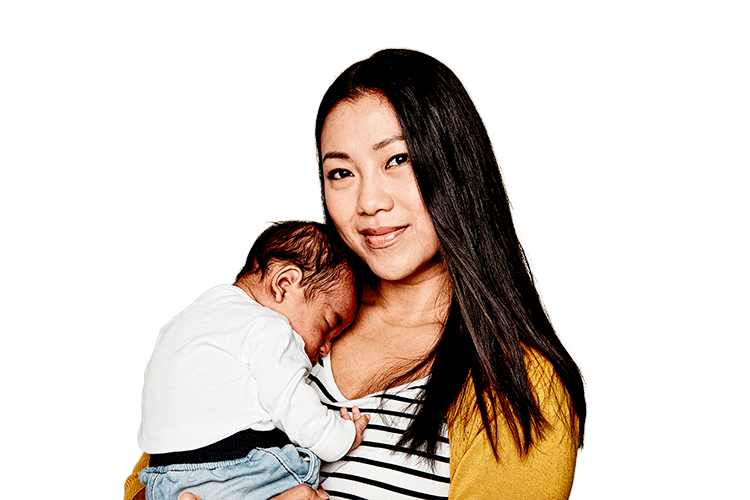If you’re pregnant or planning a family, it makes sense to have a general understanding of what a caesarean section is, and why you may need one. Although you may want a vaginal birth, sometimes things occur that are out of your control.

During a caesarean birth, the baby is delivered through a cut in the mother’s abdomen and uterus.
Compared with a vaginal birth, caesarean sections may have an increased risk of complications for both mum and baby and a longer recovery period. However in some cases, the risks of having a baby vaginally outweigh the risks of a caesarean.
Caesareans can be elective (planned) or emergency (not planned).
Factors that increase the likelihood of a caesarean
The likelihood of having a caesarean increases with age. Mothers aged 40 and over are almost three times more likely to deliver by caesarean, compared with teenage mothers. Pregnant women who are obese are also more likely to deliver via caesarean section.
Reasons you might need an elective caesarean
There are a number of reasons you may need a planned caesarean birth, including:
- You have previously had a caesarean section (although a prior caesarean doesn’t always necessitate another)
- Maternal medical conditions such as diabetes or high blood pressure
- You are having twins or triplets
- The baby is too big to fit through your pelvis
- Your baby is positioned bottom or feet first (breech) or sideways (transverse) and can’t be turned
- You have placenta previa, which means your placenta is blocking your cervix.
It is important to note that not all women will necessarily have caesareans in these circumstances. Each case is different and the decision will depend on your personal situation, and sometimes, preferences.
Reasons you might need an emergency caesarean
An emergency caesarean is required when unforeseen complications arise during labour and surgical intervention is needed to ensure the health of mother and baby. Some of the reasons for an emergency caesarean birth include:
- A maternal health problem, such as high blood pressure, is putting you or your baby at risk
- Your labour fails to progress or the baby’s head doesn’t move down through the pelvis
- Foetal monitoring picks up that your baby is showing signs of distress or that the baby’s health is compromised
- There is a risk the umbilical cord is around the baby’s neck.
What if I could have a vaginal birth but I want to have a caesarean?
The thought of labour can be overwhelming and particularly anxiety-provoking for some women. If you are concerned about having a vaginal birth discuss your concerns with your obstetrician or midwife.
Potential risks and complications
A vaginal birth is generally the safest option for you and your baby. However, caesareans are very common in Australia and are relatively safe. Like any major surgery, caesareans involve some risks and potential complications, including:
- A longer stay in hospital and a longer recovery
- Pain from surgery
- Scarring
- Bladder damage
- Complications from the anaesthetic
- Blood clots in the legs
- Increased maternal blood loss
- Infection in the lining of the uterus
- Infection of the wound
- Increased risks with future attempts at vaginal birth
- A need for a caesarean section for future births.
Babies born by caesarean section sometimes have temporary breathing difficulty and have an increased risk of childhood asthma . About 1 to 2 out of every 100 babies may get a cut during the procedure, but it’s usually small and shallow and heals up without issues. Sometimes thin adhesive strips are used while the cut heals.
Make sure to talk to your doctor about how likely the risks and benefits are in your individual circumstances. Factors such as whether you’re a healthy weight can impact on certain risks.
Find out about what will happen on the day and how to look after yourself afterwards.

Looking for something else?
Visit Medibank Planning, Pregnancy and Parenting for a range of tools and advice to help you at every stage of your pregnancy journey.
Help the way you want it
Contact us
Call us on 134 190 to speak to a consultant. Alternatively, chat to us 24/7 online.
Self-service options
Login to MyMedibank or Download the MyMedibank App for self service options.
Find a specialist
Find a specialist or Member's choice hospital using our find a provider tool.

Sources
https://ranzcog.edu.au/womens-health/patient-information-resources/caesarean-section
https://www.aihw.gov.au/reports/australias-health/australias-health-2018-in-brief/contents/births-in-australia
https://www.aihw.gov.au/reports/per/095/ncmi-data-visualisations/contents/labour-birth/b5
http://www.aihw.gov.au/publication-detail/?id=60129557656
https://www.betterhealth.vic.gov.au/health/healthyliving/caesarean-section
http://www.pregnancybirthbaby.org.au/caesarean
https://www.nichd.nih.gov/health/topics/pregnancy/conditioninfo/Pages/cesarean.aspx
https://nichd.nih.gov/health/topics/obstetrics/conditioninfo/pages/after-cesarean.aspx
https://www.nature.com/nm/journal/v22/n3/full/nm.4039.html
https://aacijournal.biomedcentral.com/articles/10.1186/s13223-019-0367-9
https://thorax.bmj.com/content/64/2/107
https://pubmed.ncbi.nlm.nih.gov/26825289/
Things you should know
~ Some referred services may involve out of pocket costs and waiting periods may apply.
# Health Concierge is available to all eligible Medibank members who hold hospital cover. Excludes Overseas Visitor Health Cover, Working Visa Health Cover and Overseas Student Health Cover (OSHC). Some referred services may involve out of pocket costs.
While we hope you find this information helpful, please note that it is general in nature. It is not health advice, and is not tailored to meet your individual health needs. You should always consult a trusted health professional before making decisions about your health care. While we have prepared the information carefully, we can’t guarantee that it is accurate, complete or up-to-date. And while we may mention goods or services provided by others, we aren’t specifically endorsing them and can’t accept responsibility for them. For these reasons we are unable to accept responsibility for any loss that may be sustained from acting on this information (subject to applicable consumer guarantees).